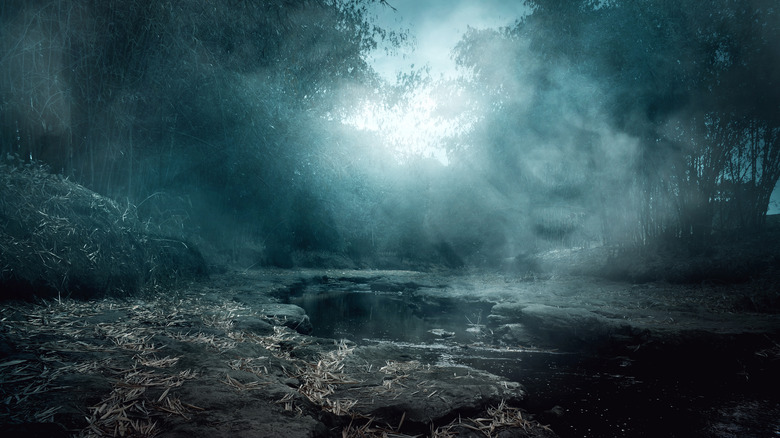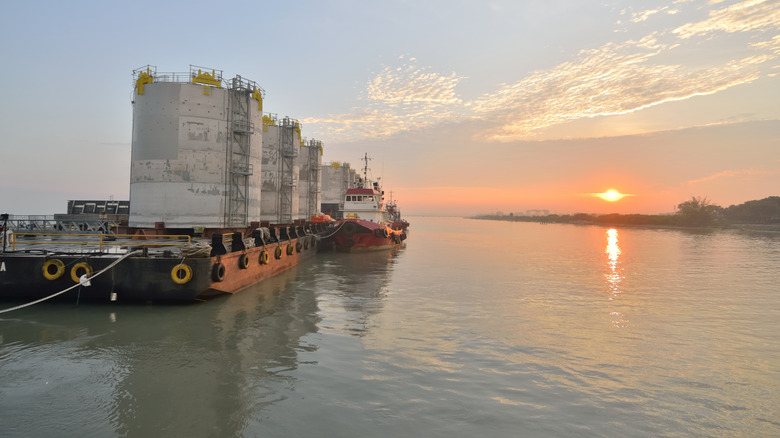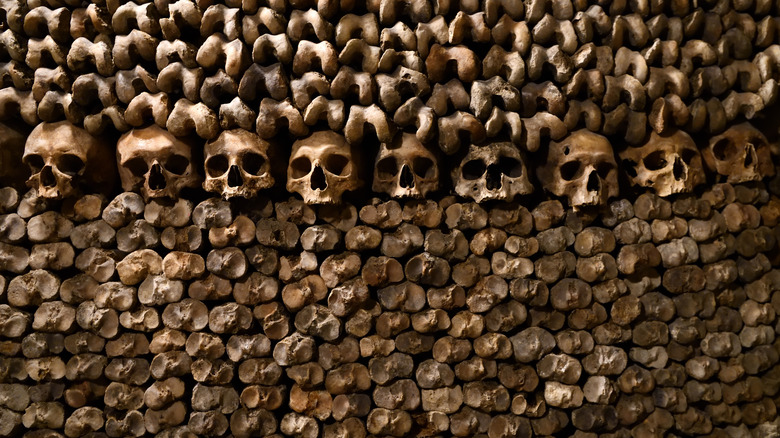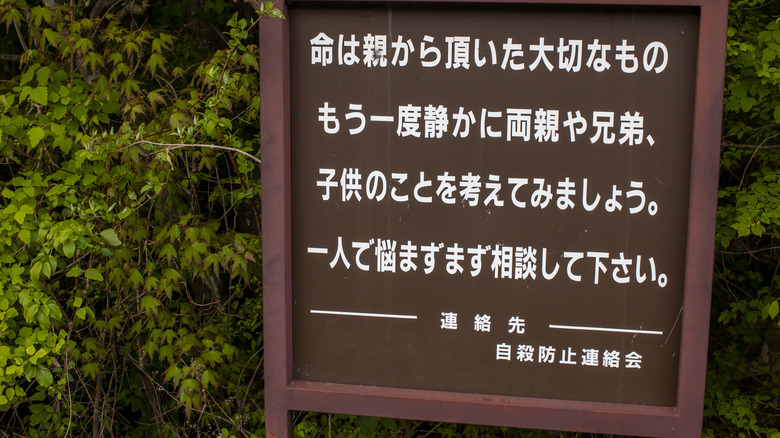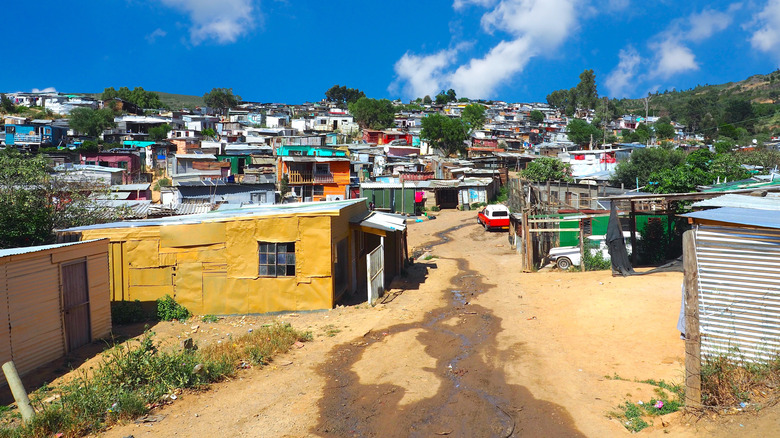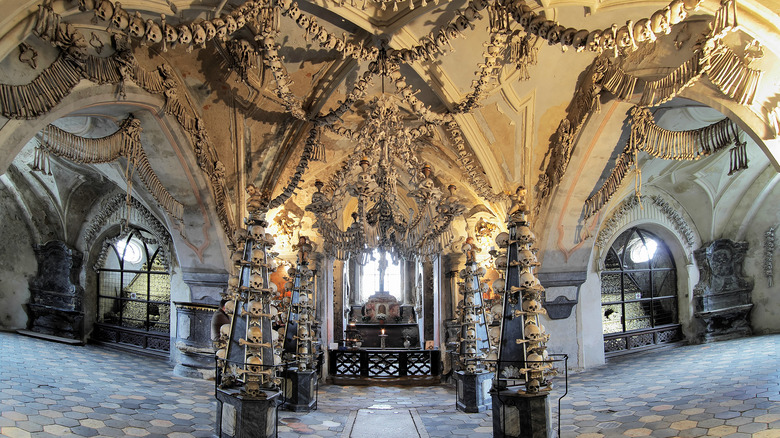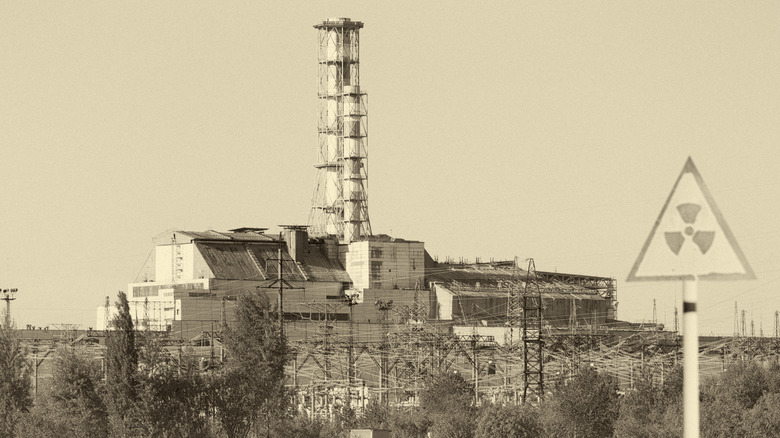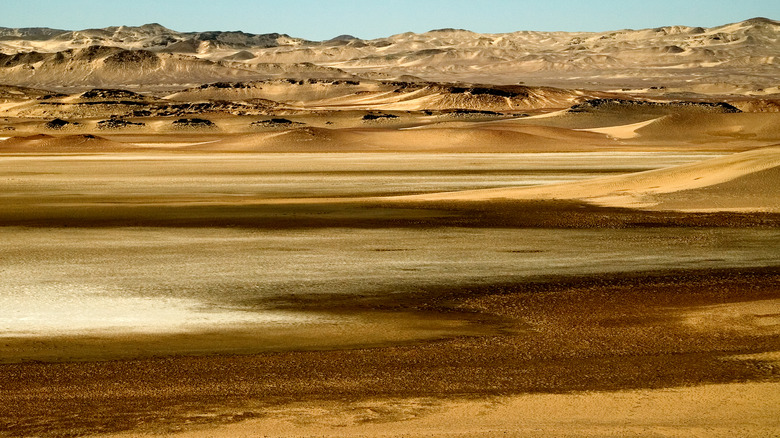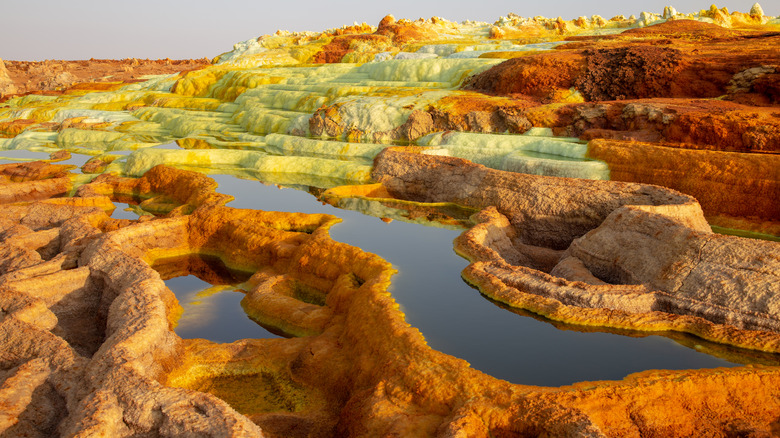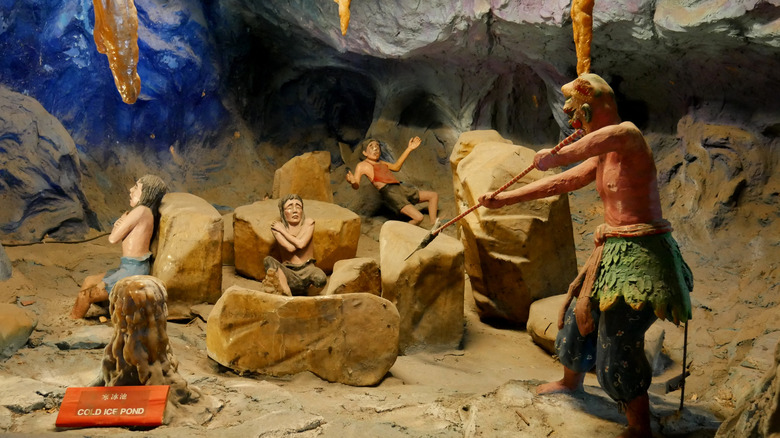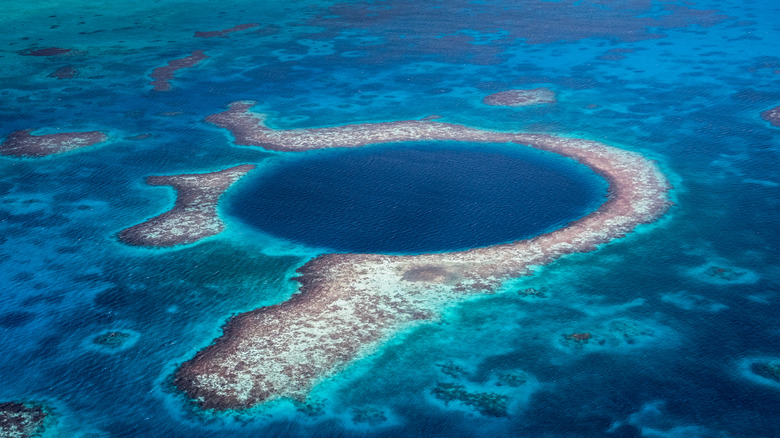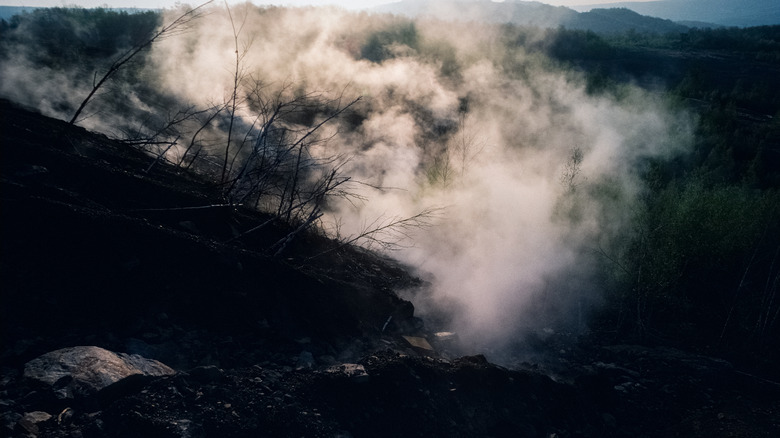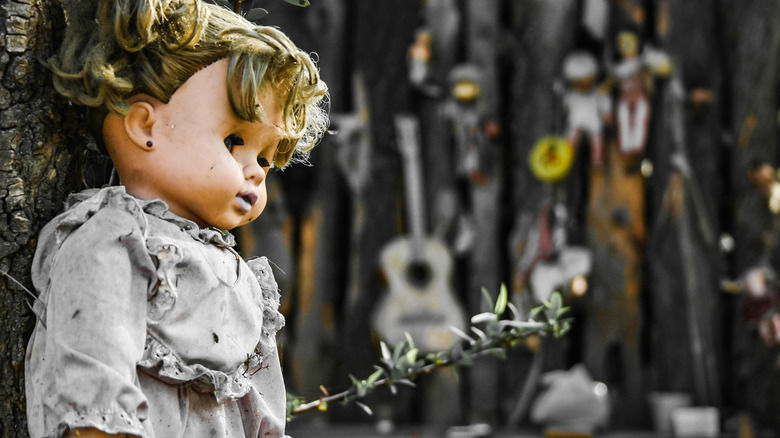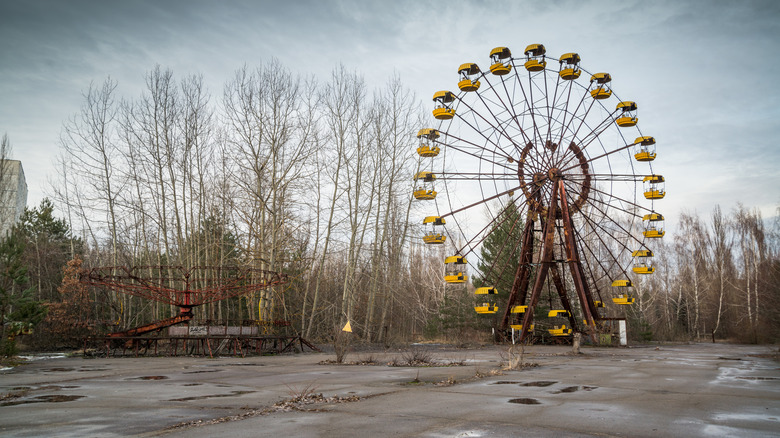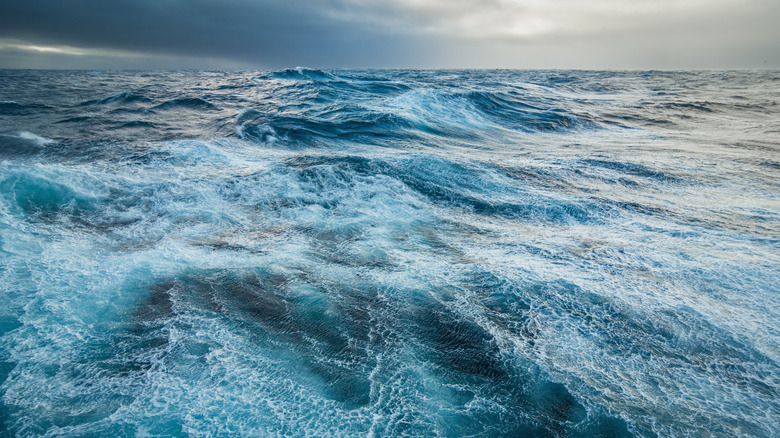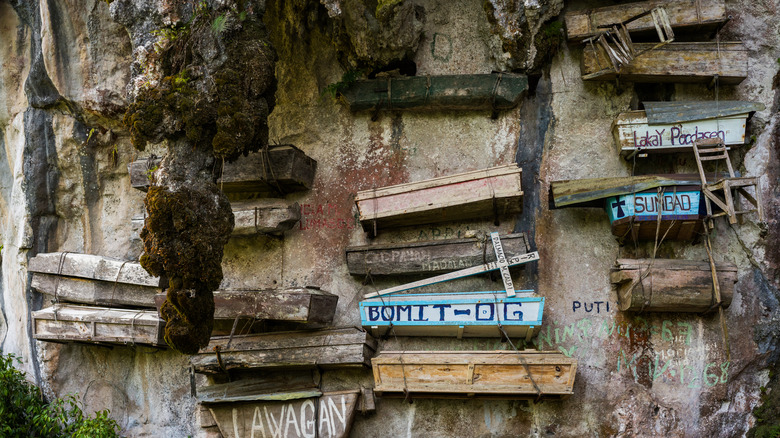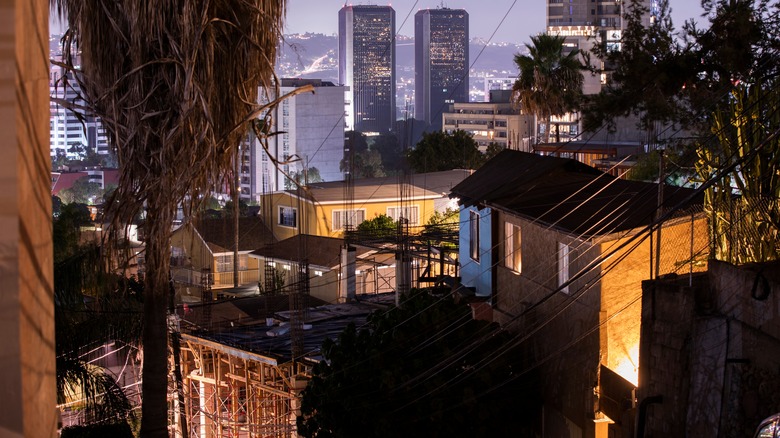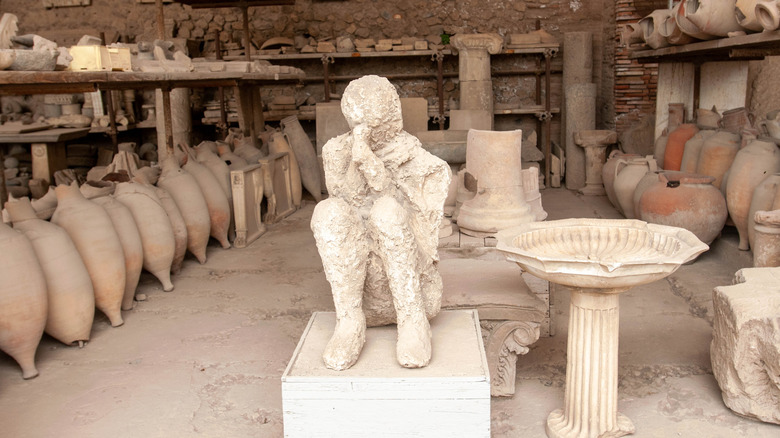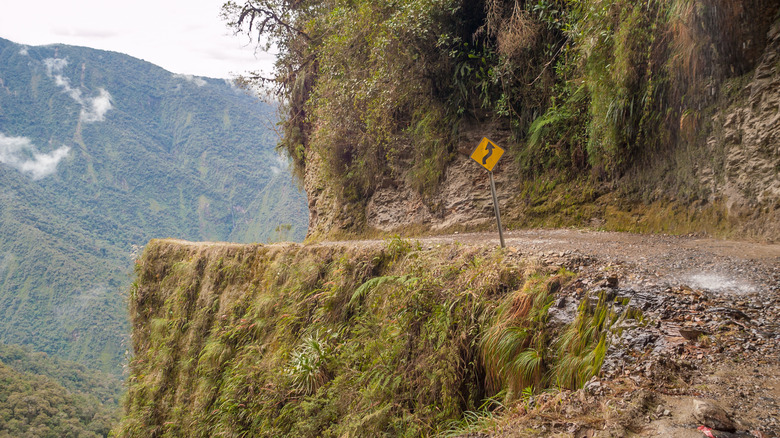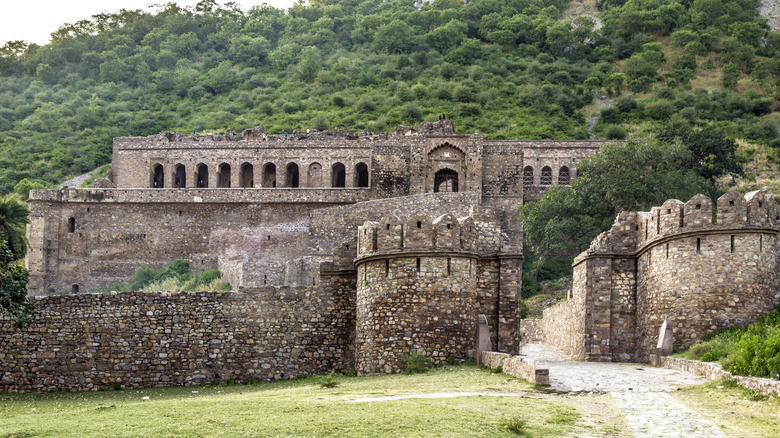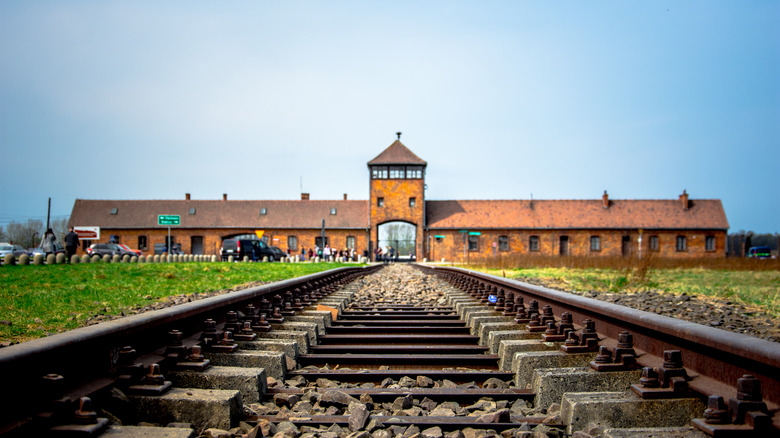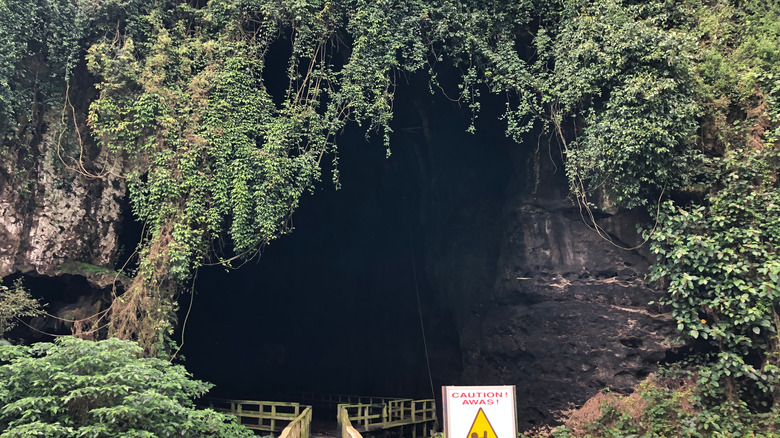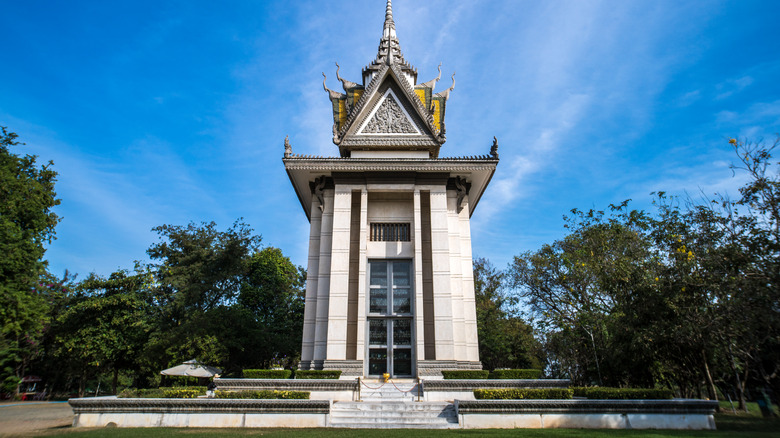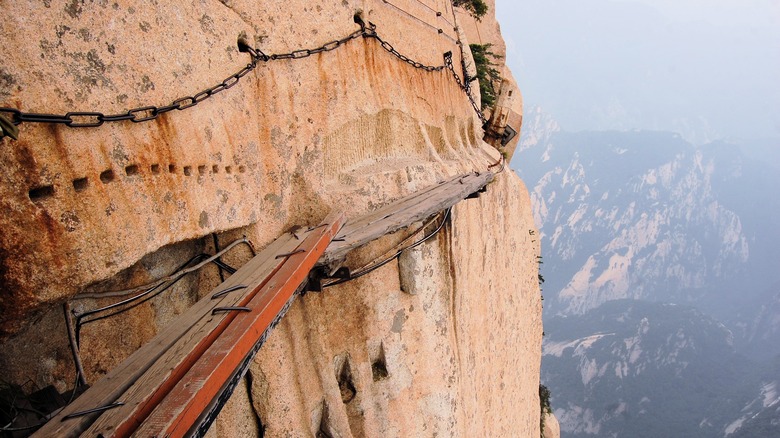25 Most Terrifying Places On Earth
The world is a big place with more than its fair share of scary locations – big, small, and outright troubling. Some of the most terrifying places on Earth are considered scary because they're dangerous. Others echo atrocities from our shared human past in wounds that can still be felt by the people of today, are believed to be inhabited by supernatural forces, play on the subconscious mind by forcing us to face the truth of our mortality, or just send shivers up our spine for various other reasons. But one thing is certain about all the locations on this list: They are absolutely terrifying.
Regardless of what your personal fears may be, there are places on this list that would likely send you running. Where a number of these places can be visited by the brave, others are best left to be viewed from the safety of the internet, and there are a few deemed entirely off-limits.
1. Ilha da Queimada Grande, Brazil
Ilha da Queimada Grande is an island off the coast of Brazil, and though it has beautiful jungle scenery and potential majestic beachside sunset views, you wouldn't want to be close enough to find out. There's a good chance you've heard of Ilha da Queimada Grande already, but you probably know it by its more common name: Snake Island.
It doesn't really matter if you have a fear of snakes at all, if you have any semblance of our ancient forefathers' survival instincts left, you'll be terrified of Snake Island. This island is home to thousands of, as the late Steve Irwin would put it, "absolute beauties" or "deadly venomous snakes." The golden lancehead viper can kill a person with a single bite, and they're at the top of the food chain on Ilha da Queimada Grande. There's literally nothing on the ground capable of eating these slithering predators.
Due to the danger Snake Island and its vipers pose, visitors can't touch shore without approval from the Brazilian government and marking off a checklist of credentials. But unless you're a very specified herpetologist, you probably wouldn't want to go near the island to begin with.
2. The Cecil Hotel – Los Angeles, California
The Cecil Hotel has a long, sordid history. Today it's known as The Cecil Hotel Apartments and serves as low-income housing. Though it's nowhere in the official history, it wouldn't be all that surprising if the new use for the building came about from the dwindling pool of customers since so many of them died at the hotel over the years.
The most recent tragedy to take place at the Cecil, and one that prompted the Netflix documentary "Crime Scene: The Vanishing at the Cecil Hotel," was the disappearance of college student Elisa Lam who checked in but never checked out. Her remains were later discovered in the building's water tank. Though this was the last known mysterious death at the Cecil, tragic accidents, suicides, drug overdoses, and more can be traced back through the decades to the first known death in 1927. As if the darkness of this location drew in the darkness of humanity, two serial killers spent time in this Los Angeles hotel. "The Night Stalker" Richard Ramirez called the Cicel his home while he took lives during the 80s, and Jack Unterweger lived in the hotel while strangling sex workers in the early '90s
[Featured image by Jim Winstead | via Wikimedia Commons | Cropped and scaled | CC by 2.0]
3. The Strait of Malacca between Indonesia and Malaysia
If there's one thing people think of when they hear the words "Southeast Asia," it's pirates. Okay, maybe not, but in the 500 miles of water that separates Indonesia and Malaysia, known as The Strait of Malacca, pirates should definitely be on your mind. The pirates of today aren't all peg legs, eye patches, and yo-ho like the pirates of yesteryear, but they're certainly just as much of a danger to civilian crafts and shipping vessels. Maybe more so since our modern technology means modern navigation methods and modern weapons.
The strait was the site of nearly 70 acts of piracy or attempted acts of piracy in 2021 alone, according to Statista. That accounts for more than half the pirate attacks worldwide. Malacca Strait pirates aren't exactly after gold and treasure, but they've been known to steal millions of dollars worth of fuel from tankers, cash, any equipment that might be worth a buck, and, of course, cargo.
4. The Catacombs – Paris, France
With the remains of over 6 million people buried within and lining the walls of centuries past, the hundreds of miles-long catacombs beneath Paris, France, are a creepy sight to behold. The walls are ornately decorated with the skulls and femurs of the dead, with some of the remains dating back to the 15th century. The tunnels are long, dark, and underground. The smell of earth and bone, while pleasant to some, may trigger base instincts in others, warning them to run from a place that is truly a subterranean palace of death. While walking these halls, you'll constantly be reminded of your own mortality, which can be freeing or outright terrifying, depending on your level of acceptance.
It's not surprising, given the number of remains within the catacombs, that some believe this place to be the home of wandering spirits. In a place with so many dead, surely there are those with unfinished business who remain tied to this plane. Well, if you believe in that sort of thing, anyhow. If you don't, the confined spaces, darkened corners and tunnels, and the consistent homage of human impermanence are enough to raise the hairs on the back of your neck.
5. Aokigahara Forest – Honshu, Japan
Aolkigahara Forest on the main island of Honshu, Japan, is both an eerie place and a tragically sad one. Located at the foot of the majestic Mt. Fuji, one of the world's greatest mountains, the beauty of this forest stands arguably unrivaled. And maybe it's that beauty that's drawn so many to take their lives in the wood colloquially named "Suicide Forest."
The first thing you'll notice upon entering Aokigahara is a sign that talks about the precious nature of life, reminding those set on ending their existence about the loved ones they'd be leaving behind. The sign was posted due to the number of suicides that happened in the forest. In the two years between 2013 and 2015, more than 100 victims have succumbed to their dark thoughts in Aokigahara, and it's not entirely uncommon for visitors to find others when visiting the forest today.
The cause of the tragic phenomenon isn't known for certain. It could be that those unfortunate souls wanted to move on in peace, undisturbed in their act. Maybe they felt like a forest away from town would remove much of the burden that comes with stumbling upon the scene or provide camaraderie with those who'd taken their lives in the forest previously. Or maybe, there's something else at work we don't yet understand. If you or someone you know is struggling or in crisis, help is available. Call or text 988 or chat at 988lifeline.org.
6. Cape Flats – Cape Town, South Africa
The Cape Flats area of Cape Town in South Africa is one of the most dangerous places in the world for violence, if not the most dangerous. This impoverished area is overrun with gang activity, likely stemming from the poverty associated with apartheid. As should be common knowledge these days, crime and poverty go hand-in-hand. Even so, the violence in the Cape Flats of Cape Town is a little extreme.
In only six months of 2019, almost 1,000 people were murdered, according to The Guardian. That many people in a county, or even a city, would be bad enough, but the Cape Flats are only a portion of a city, making it about as close to a gang warzone as you can get. Stepping out the front door in Cape Flats must be terrifying enough for residents and unimaginable for visitors.
This area of Cape Town has a relatively recent and tragic history as well since it was where the majority of Black residents moved when places became segregated during apartheid. For reference, apartheid only ended in the 1990s.
7. The Sedlec Ossuary – Kutná Hora, Czech Republic
The Sedlec Ossuary in Kutná Hora, Czech Republic, which is only about an hour's drive from Prague, is a place of macabre fascination and horror. There's a certain beauty in the artistry at Sedlec Ossuary if you happen to have a fascination with death, dark tourism, or artwork drawn from the creepiest part of the human mind. However, if you get chills in graveyards or at mortuaries, you may be absolutely scared to death. Or scared by death, if you catch our drift.
Imagine entering a Roman Catholic chapel where the archways were made of real human remains, with the empty wells of sockets that once housed living eyes staring down at you from chandeliers constructed of bone and skull, and you'll get a pretty good sense of Sedlec Ossuary. Cherubs blowing golden trumpets sit upon pedestals of what appears to the imagination as a collection of skulls from their conquered adversaries. The prominently displayed coat of arms is likewise constructed of human remains, as are the ornate crosses, decorative garlands, and wall fixtures. Death is the theme of this Church of Bones.
8. Chornobyl Nuclear Accident Site – Chornobyl, Ukraine
Radiation is terrifying. It's the most destructive force in the universe, capable of dismantling matter on a subatomic level, and it has the potential to stick around for thousands of years once a site is contaminated with radioactive waste or irradiated in an unfortunate accident. Such is the case of the Chornobyl Nuclear Accident, where a faulty nuclear reactor dumped radiation on the town of Chornobyl, Ukraine, causing mass evacuation and widespread radiation-related health incidents. Now, intense radiation didn't linger here for millennia but was carried across Eastern Europe and Russia on the wind.
After several deaths and the long-term contamination of the Chornobyl area following the nuclear accident, parts of the site can now be visited when the country isn't being actively invaded. Though that's not something you'd want to do without a special guide is needed. As far as radiation is concerned, it's not really much of a problem these days since the levels are deemed relatively safe. It's the decaying buildings themselves that have become the danger. Regardless, the city's history of death and evacuation, as well as the reminder of the long-term biological and environmental damage humans are capable of, is pretty scary stuff.
9. Skeleton Coast – Northern Namibia
If you were ever so inclined to feel our nomadic ancestors' primal fear when they hiked across miles of empty country in search of migrating game or fresh resources, Skeleton Coast is the place you want to be. This place is truly eerie. The area on the northern coast of Namibia, known as Skeleton Coast, is 300 miles deep of nothingness. To complete the scene, uncountable animal bones are scattered around the ocean shore. It's uncertain whether they were washed up from the current or left by dying animals on a desperate search for lifesaving water or food that was never fulfilled.
Food is scarce on Skeleton Coast, to say the least, but so is everything else other than dirt and sand. The idea of breaking down here with no contact, left in the vast emptiness with no one to save you, no food to eat, no fresh water to drink, and hundreds of miles to hike to the nearest human settlement is absolute terror. The only thing to keep you company would be the Sun-whitened bones and the wreckage of ships that couldn't tame the Atlantic you found along the beach.
10. Danakil Depression – Ethiopia
It's not so odd that scientists visit the Danakil Depression in the northeast of Ethiopia. It is, however, almost weird that tourists flock to it though. Maybe they simply don't understand what they're getting into, or perhaps, they find the alien nature of this natural wonder intriguing. Be that as it may, this place is one of the most terrifying places on Earth.
To start with, the heat of the Danakil Depression itself is deadly, with temperatures that can reach 125 degrees. That makes this inhospitable location the hottest in the world, according to USA Today. Scientists study the depression to determine how life could possibly live on Mars, a planet with no atmosphere or life-providing resources. The only thing that maybe thrives in what some have labeled "The Gateway to Hell" is a handful of microbes. Nothing else can drink the acidic salt water that's heated by magma barely below the dirt. The air contains toxic chlorinated and sulfurous fumes. And to top it all off, there's a literal lake of lava in Danakil's Erta Ale volcano.
11. Haw Par Villa – Singapore
Haw Par Villa in Singapore is a Chinese cultural museum that showcases traditional Chinese mythology with statuesque scenes and exhibits that are pure artistry. It's also home to Hell's Museum, which serves intentionally or unintentionally as a way to revisit traditional spiritual morality. Hell's Museum — again, intentionally or unintentionally — has the added benefit of being absolutely terrifying, a perfect way to trick children into minding their Ps and Qs.
Some of the exhibits you'll find in cavern-like displays include a court of judgment, where sinners' souls are sent to one of 18 levels of Hell, depending upon the level of their indiscretions; bodies impaled on the pikes of demons while roasting over hellish flames; and creatures chucking the damned into pits of spikes and beating them. Children will surely be horrified by the statues partially stripped of clothing while having body parts removed and butchered bodies on a chopping block, all while being reminded that this Hell awaits those who refuse to properly behave. But when it's all said and done, you can play a fun little tug-of-war game between a scene of heavenly clouds and one of hellfire. That's a bright side, right?
12. The Great Blue Hole – Belize
The Great Blue Hole right off the coast of Belize is the most dangerous underwater sinkhole in the world. This place is incredibly terrifying for those with water-related fears. It has a depth of around 400 feet, and it's hard to say what might be lurking in those depths. Not to mention, the Great Blue Hole has a track record of claiming the lives of those brave enough to delve into its waters.
Belize's Great Blue Hole has attracted divers since the '70s. Besides being deep, the stalagmites that formed when the hole was still above water make it as beautiful as it is unique. No wonder adventurous folks want to check it out, but going deep could cost divers their lives. Bodies of lost divers have been found in the bottom of the sinkhole, preserved due to the absence of oxygen in depths lower than 290 feet, according to Newsweek, and it's believed more bodies might be resting somewhere on Great Blue's floor. Finding them wouldn't be easy, though. A layer of hydrogen sulfide blots out light to the lower reaches of the water, making it a pitch-black well, hungering for souls lost in its darkness.
13. Centralia, Pennsylvania
In the middle of Pennyslvania is an old mining town by the name of Centralia that once lived and breathed everything coal. These days, Centralia is basically a ghost town, and for good reason, and it's scary enough to have inspired the Silent Hill franchise. Centralia comes with all the usual creepy qualities of an abandoned town, but it has some other unique ones as well. One thing you'll notice if you ever visit, which you probably shouldn't, is the random smoke wafting against a backdrop of rundown and missing buildings. Why? The same coal that once was the town's lifeblood was also its undoing.
In 1962, the mines caught fire. Though the origin of this fire is debated, the results were the same. The mine was alit and filled with toxic smoke, killing jobs for much of Centralia's workforce. That's enough of a reason for people to abandon a town, but it gets worse. The fire is still burning beneath the town today and could continue to do so for the next 500 years, according to WGAL News. The flames heated underground gas storage for pump stations, opened sinkholes filled with deadly gasses, and began to swallow the town. The people left and never returned, listening to the signs posted warning visitors to turn back under fear of injury or death. This may be one of America's most chilling abandoned places.
14. Island of Dolls – Xochimico, Mexico
Isla de las Muñecas, The Island of Dolls, is a little island in Xochimico, Mexico, sure to scare you out of your socks. It's hard to miss since it's the only island with hundreds of tattered and worn dolls hanging from the trees. If the dolls with their wandering eyes that seem to follow your every movement aren't scary enough, the story behind them might be.
According to the legend, the island's caretaker Don Julian Santana Barrera came across the body of a girl who'd drowned at the island. Later, the same man found a doll floating in the water. Santana Barrera was haunted by the girl's ghost and wagered that the doll could help appease her restless spirit. He hung the doll on a tree and has since suspended many others. Though it's likely this incident never happened, and many accuse the caretaker of telling tall tales, visitors have reported seeing the dolls move on their own. Some believe these dolls now serve as vessels for the dead who refuse to move on from this world.
15. Pripyat, Ukraine
The abandoned ghost town of Pripyat in Ukraine is directly linked to the Chornobyl incident discussed above. The city is only about a ten-minute drive from the power plant and was one of the first places evacuated during the Chornobyl Accident due to that proximity. The townspeople departed in a hurry, leaving behind their belongings as a snapshot of life that seemed to have rotted away. Very much like a 20th-century Roanoke, minus the word "Croatoan" carved into a tree, of course.
One of the creepier sights to behold is the abandoned Farris wheel standing in a vacant parking lot, rusting in its loneliness. The silence where life should be will bring you goosebumps, and the dolls placed in bedrooms from their last play with the children who abandoned them in the pursuit of safety will supply the chills. Buildings are degrading with the flow of time, and the wild is beginning to consume the evidence of humanity at Pripyat one brick at a time. Standing in the town will make you feel like you're witnessing the aftermath of an apocalypse, and for the people who once lived here, it was basically just that.
16. Drake Passage – Antarctica
Drake Passage is a common way how to get to Antarctica from South America because it's a relatively short, direct route, but it's also a dangerous one that'll test the mettle of even the most hardened sailors. The swells can be dangerous, with waves upwards of 40 feet, and ice debris can come out of nowhere. The number of shipwrecks within the freezing waters of Drake Passage varies, but since it was a standard trade route back in the day, most sources put the number in the hundreds.
You might be thinking that we left the dangers of sea travel behind when we moved into the futuristic age of today, and you'd only be partially correct. Modern technology and weather predictions have certainly made this trip less dangerous. That doesn't mean it's safe or pleasant. Many sea-goers would still find it terrible or outright horrifying. For example, an Antarctic cruise ship took a beating from harsh weather and high swells in 2010 that knocked out one of its engines and very likely scared the daylights out of the passengers. And these conditions are all but uncommon.
17. Hanging Coffins – Sagada, Philippines
Around the village of Sagada in the Philippines, you'll notice what some may deem a horrifying sight. Instead of burning their dead in the ground, out of view, the locals hang their deceased in coffins along the cliffsides, one above another. This can be quite eerie to those from Western cultures, where we prefer the dead to be hidden in the ground or in stone mausoleums. The superstitious might find it difficult to hang around Sagada at all, and those still uneasy about their mortality may become more so in the presence of the deceased above them.
These coffins are typically weathered, which seems to add to the eeriness. Tied with rope or hung with nails, these resting places aren't the most secure, and though it probably doesn't happen often, there's always a chance of one tumbling down. So, add the possibility of a jump scare to the list.
It's important to remember that though these coffins may be horrifying to outside cultures, they serve a purpose for the Igorot tribe of Sagada and are meant to elevate their loved ones closer to the realm of their ancestors. If dark tourism ever drives you to visit the area, make sure to treat it with the same respect you would any other holy site.
18. Sánchez Taboada – Tijuana, Mexico
As a popular destination for spring breakers and vacationers, Tijuana, Mexico, is loaded with resorts and attractions. Better yet, it's directly across the border from California, so it's exceedingly easy to access. However, going to Tijuana might be biting off more than you want to chew, at least in the realms of terror and danger since it is the number one city for violent crime and probably one of the most dangerous places in the whole world, according to World Population Review. And Newsweek reports that the neighborhood of Sánchez Taboada is the most violent of any other in Tijuana.
With over 2,000 homicides in the city, walking down the street in Sánchez Taboada would be a scary thought for the average tourist, but it's proven to be patently dangerous for just about anyone. To put it into perspective, there are roughly two killings every day in Sánchez Taboada. Gunshots ring through the night like a neighborhood theme song. Even the police in the neighborhood have to drive vehicles that are basically tanks while geared to the teeth to do their jobs. If that's not terrifying, then who knows what is?
19. Pompeii – Campania, Italy
The site of Pompeii in Campania, Italy, is both fascinating and terrifying. In A.D. 79, Mount Vesuvius, a rather large volcano, blew its top, so to speak. The eruption was massive, and the age was too early for any sort of accurate predictions of the timing of natural disasters or where they might strike. Ash and stone rained down from the sky. Toxic gasses filled the atmosphere. Citizens of Pompeii were wiped from life but not from the Earth. The colossal amount of ash released in the eruption buried the city, preserving it for more than a millennium and a half before it was rediscovered in the 1700s. Had the citizens of Pompeii known more about conventional geology, they would've known the city was built on the site of a previous eruption.
Human remains that decomposed in the debris would've virtually disappeared with any other deadly phenomena, but thanks to the ash formed around them, hollows were preserved that granted a window into their tragic deaths. Later, these hollows were cast in plaster and put on display, assuming the positions the living took in an attempt to brave the disaster. These displays, coupled with the history of Pompeii, are tragic and horrifying. The physical reminder of how quickly life can end is truly a grim thing to behold.
20. Yungas Road – La Paz, Bolivia
Hopefully, any visitors planning to travel Yungas Road in Bolivia aren't scared of heights. This road is arguably the most terrifying in the world, and if not, it's at least the most famous of the frightening roads out there. For over 20 miles, visitors can enjoy a thin, winding gravel and dirt path barely as wide as a car. The cool thing about this road is the mountain views on all sides. The terrifying thing about this road is the drop-off lining one side that'll send unfortunate folks to a most certain death. And as a bonus, no guard rails!
Yungas Road has earned the name "Death Road" because of the hundreds of people known to die from accidents here, including buses full of travelers. To be fair, it's not very easy to survive a fall of up to over 10,000 feet, whether or not you're protected by the steel body of a vehicle. Luckily, the death rate has dropped since a new road was built, taking travelers to the same destination. The road is still open though, if you're brave enough to check it out.
21. Bhangarh Fort – Bhangarh, India
Once the seat of power for an entire kingdom in the 17th century, Bhangarh Fort in India was likely a beautiful place with a palace, stables, housing, the whole nine yards. Since those days, it's been reduced to weathered ruins, as typically happens when time moves forward and buildings are left with no one to preserve them. What isn't so typical is the fort's current inhabitants: restless spirits.
The fort is believed to be the most haunted place in India, and good luck convincing locals otherwise. Legend says that any visitor who goes into Bhangarh Fort after dark will perish, and the people in the area take this myth quite seriously. In fact, so does the government. It's actually illegal to enter the fort at night, and signs are posted everywhere warning potential victims of ghastly phenomena to turn back before the sun sets.
The story behind the hauntings goes as such: A queen who ruled the fort was cursed by a man who vied for her affections after she'd turned him down. The curse was meant to destroy the fort and all those inside, so some of them fled. The village was destroyed, and those who remained at Bhangarh are still there, plaguing the grounds, unable to move on.
22. Auschwitz Memorial – Oświęcim, Poland
The most terrifying part of the Auschwitz Memorial in Oświęcim, Poland, is the proof of how tragically far and terribly cruel the worst among us are willing to go in order to achieve their goals. Auschwitz, as you may already know, was the largest Nazi death camp in World War II, and though there may not be ghosts haunting the memorial, the specter of this dark piece of human history is genuinely haunting enough on its own.
Auschwitz was the place of places for Nazis to execute their "enemies," which mainly consisted of innocent Jews trying to live their lives without becoming the tragic victims of hate. According to the Auschwitz-Birkenau Museum, slightly over 1 million people were executed at this site by vulgar means, including toxic gas, firing squad, lynching, and, to prove Nazis were indeed the worst of humanity, the slow, painful death of starvation. This is where Auschwitz differed from other camps that used prisoners as workhorses. Those sent to this camp weren't meant to survive. It was only a matter of time before their execution was in motion.
The memorial allows you to tour the camp and see these tragedies for what they were in hopes that we'll never forget our past and repeat these atrocities again.
23. Gomantong Caves – Borneo, Malaysia
This one goes out to everyone terrified of the creepy crawlers of the world. The Gomantong Caves in Borneo, Malaysia, are absolutely packed with some of the critters known to rub people the wrong way and invoke unjustified terror in certain folks. To add insult to injury, the cave system is just that, and we know there are those of you out there with fears of the dark or of enclosed, cramped spaces. But the real draw here (or aversion, in this case) is the animal life.
Inside the rocky cave, visitor's sensibilities are assaulted from every direction. Above, you can spot the countless bats clinging to the ceiling or flying overhead. Below, the swarms of giant cockroaches sift through the guano that lines the cave floor. According to Wildlife World, 27 different species of bats live within this cave, along with a handful of species of cave-dwelling birds known as swiftlets. While the number of species here is impressive, the sheer number of bats in the caves is insane, with an estimated 2 million of the winged mammals calling Gomantong home. The roaches likely number in the millions as well, but since they're so packed into tight droves that make the rocks seem to move of their accord, they're difficult to count.
24. The Killing Fields – Phnom Penh, Cambodia
The Killing Fields in Phnom Penh, Cambodia, is the site of one of humanity's worst and lesser-known tragedies, and like many of the other tragic horrors on this list, it's routed in human folly. The fields today are a peaceful place where visitors go to remember the past and pay respects to the millions killed in the most terrible event in Cambodian history.
After the Cambodian Civil War in the '70s, the Khmer Rouge (Cambodia's communist party) came into power. The first thing on their docket was to restructure the country, and they did so in a bloody fashion. Almost a quarter of the Cambodian population was slaughtered at the hands of the new regime, and up to 70% of the Cham ethnoreligious group, according to the University of Minnesota. Torture, beatings, mistreatment of children, the executions mentioned above, and just about any terrible deed you can think of happened during this period at what is now called The Killing Fields.
The remains of the victims of the Cambodian Genocide are buried beneath the soil of this site in mass graves, and if you believe at all that torment of this magnitude can leave scars subtly perceptible to the human psyche, you'll find The Killing Fields to be a frightful place.
25. Mount Hua – China
Mount Hua, located in China's Shaanxi Province, is a jagged monstrosity of rock that rises high into the skyline. It's a beautiful mountain with religious significance tied to the Taoist temple at its base, which is probably a good stop for most people who don't want to go on the most terrifying hike of their lives up the mountainside.
To hike to the southern peak of Mount Hua, over 7,000 feet in the air, adventurers have to walk an uneasy path, literally. The way up is a walkway fastened to the sheer side of the mountain. Thin, old wooden planks separate you from a fall that guarantees your death if you don't choose to rent one of the safety harnesses. There's no guard rail, and it's easy to become disoriented while looking down. Nowadays, many hikers taking the mountain path are harnessed for their safety, but with the walkway being only a few feet wide, anchored in the way it is, and with people hiking in both directions, you don't have to be acrophobic to find this place horrifying. Drop a small pebble off the walkway, and you'll see why.
